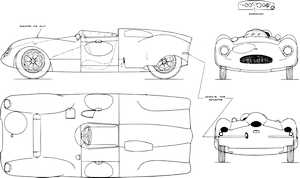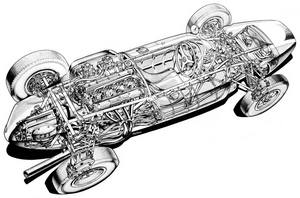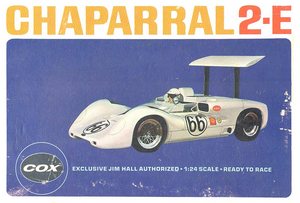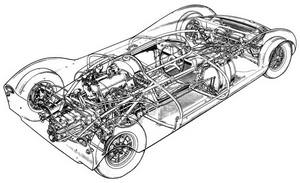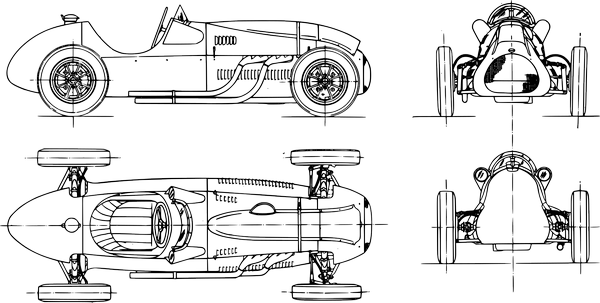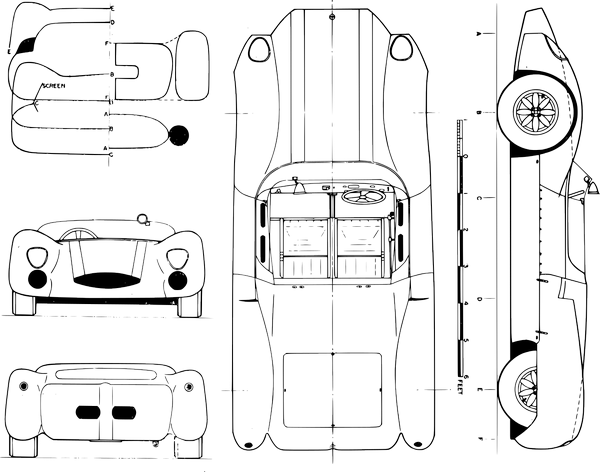Prototype Parade No. 51 | Model Maker June 1953 | Drawn & described by C. J. Prebble
The 1953 Mk. VII can be powered by either a single cylinder J.A.P. or Norton engine. The J.A.P. is a 497 c.c. air cooled o.h.v. alloy unit with a bore of 80 mm. and stroke of 99 mm. With a 14 to 1 compression ratio, the engine develops 45 b.h.p. using alcohol fuel.
The other engine, as fitted to the car in the drawing, is the latest Norton power unit which originates from the "featherbed" framed racing motor cycle of that manufacture. With a bore of 79.62 mm, and stroke of 100 mm, the engine gives about 50 b.h.p. at between 6,500 and 7,000 r.p.m. This engine is a twin o.h.c. all alloy unit.
Carburation on both engines is by a single Amal instrument with two pressure fed S.U. float chambers. The primary chain drives either a four-speed Manx Norton or Burman gearbox, the secondary chain runs from this box to a sprocket mounted on an electron case in which the shaft bearings are housed. An A.C. fuel pump is also fitted to this casing, the drive being an eccentric on the sprocket shaft.
Independent rear suspension is fitted and is operated by a transverse leaf spring. No differential is incorporated in the car. The front suspension, too, is independent by wishbone and transverse leaf spring. This year the rack and pinion steering box has been lowered to the same plane as the front wish-bones, thus making it more geometrically correct.
Eight inch Lockheed hydraulic two leading shoe brakes with 1½ in. wide linings are fitted to the front and rear wheels, the cylinders being mounted on cast electron backplates of Cooper manufacture. Electron plays a large part in the construction of the Cooper 500 and 1,100 c.c. cars, one example being the rear wheel carriers, which are cast to accommodate the wheel bearings, wishbone pins and spring shackle pins.
The chassis is constructed of 1½ in. dia. 16 gauge steel tubing, two parallel tubes 9 in. forming the side members, and tied together with cross tubes. The engine is rigidly mounted by electron plates just behind the driver. The method of attaching the rear spring to the chassis has been altered this year, the spring being allowed to move transversely by means of swinging links an unequal distance apart. By this arrangement the body roll on corners causes the rear wheels to lean towards the inside of the corner, thus assuming the correct camber angle for the corner.
On the front the free movement of the spring is curtailed by two stops projecting from the chassis in such a way that when the body rolls beyond the required amount the middle part of the spring is put out of action so giving the effect of a shortened wishbone, keeping the wheels upright in the corners.
The driver's seat has been lowered by about 2 in.; this necessitates the fitting of a complete undertray to the car. The fuel tanks are situated in the side panels of the car, two in the front and two in the rear. In the case of the "featherbed" Norton and the 1,100 c.c. engine, the oil tank takes the place of the off-side rear fuel tank instead of being situated in front of the engine as in the 500 c.c. J.A.P. and Manx Norton units. The recognition feature of the Mk. VII Cooper with this "featherbed" Norton engine is the presence of a second filler cap for the oil tank on the off-side rear panel.
The body is devoid of any air scoops, the cooling air getting to the engine via slots beside the seat and in the top of the bonnet and leaving via louvres. The engine does not run very hot as the use of alcohol fuel enables the motor to work at lower operating temperatures. Cooper 15 in. dia. electron wheels are fitted with 4.00 in. by 15 in. tyres at the front and 5.00 in. by 15 in. at the rear.
An unusual feature is the fact that the brake drums are cast integral with the wheels. The car only weighs about 550 lb., and with 52 b.h.p. the performance is pretty startling, maximum speed being about 115 m.p.h. The 1,100 c.c. Cooper differs only in the fact that it has a 1,100 c.c. J.A.P. V-twin o.h.v. air cooled engine with a bore of 84 mm. and stroke of 99 mm. The chassis is lengthened 1 in. to accommodate the engine, making the wheel-base 7 ft. 4 in. against 7 ft. 3 in. for the "500". The car is 50 lb. heavier in weight but makes up for it in the fact that the engine develops 95 b.h.p. at 6,000 r.p.m. on a 14 to 1 compression ratio.
The "1,100" looks identical to the "500" save for the twin exhaust pipes and extra filler cap as previously mentioned. 1,100 c.c. cars are generally used in sprints, hill climbs as well as being eligible in the 1,100 c.c. capacity races. At times these cars have out-performed cars of twice and three times their capacity. Several of the cars used for hill climbs are fitted with superchargers.


